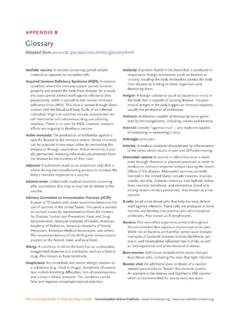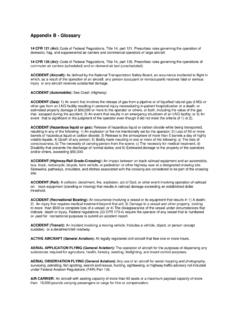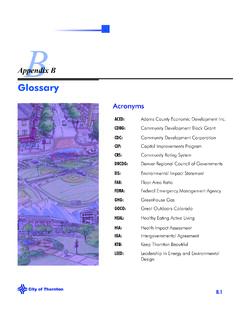Transcription of Glossary of Terms - US EPA
1 appendix B Glossary of Terms This page intentionally left blank. appendix B Glossary of Terms September 2012 B-1 appendix B. Glossary OF Terms This Glossary includes a collection of some of the Terms used in this manual and an explanation of each term. To the extent that explanations provided in this Glossary differ from those in EPA regulations or other official documents, they are intended for use in understanding this manual only. Approval Authority The director of a National Pollutant Discharge Elimination System (NPDES) state with an approved state Pretreatment Program and the appropriate EPA Regional Administrator in a non-NPDES state or NPDES state without an approved state pretreatment program [40 CFR (c)]. Baseline Monitoring Report (BMR) A report submitted by categorical Industrial Users within 180 days after the effective date of an applicable categorical Standard, which indicates the compliance status of the user with the categorical Standard [40 CFR (b)].
2 Best Management Practices (BMPs) Schedules of activities, prohibitions of practices, maintenance procedures, and other management practices to implement the prohibitions listed in 40 CFR (a)(1) and (b). BMPs also include treatment requirements, operating procedures, and practices to control plant site runoff, spillage or leaks, sludge or waste disposal, or drainage from raw materials storage [40 CFR (e)]. Best Professional Judgment (BPJ) The highest-quality technical opinion of a permit writer, after consideration of all reasonable available and pertinent data or information, forming the basis for the Terms and conditions of a permit. Categorical Pretreatment Standards Any regulation containing pollutant discharge limits promulgated by EPA in accordance with sections 307(b) and (c) of the Clean Water Act, that apply to specified process wastewaters of industrial categories [40 CFR and Parts 405-471].
3 Categorical Industrial User (CIU) An Industrial User subject to categorical Pretreatment Standards or categorical Standards. Combined Wastestream Formula (CWF) Procedure for calculating alternative discharge limits at industrial facilities in which a regulated wastestream from a categorical Industrial User is combined with other wastestreams before treatment [40 CFR (e)]. Concentration Limit A limit based on the mass of pollutant per unit volume, usually expressed in milligrams per liter (mg/L). Control Authority A POTW with an approved pretreatment program or the Approval Authority in the absence of an approved POTW pretreatment program [40 CFR (f)]. Conventional Pollutants Pollutants typical of municipal sewage, and for which municipal secondary treatment plants are typically designed; defined by federal regulation [40 CFR ] as biochemical oxygen demand (BOD), total suspended solids (TSS), fecal coliform bacteria, oil and grease, and pH.
4 appendix B Glossary of Terms B-2 September 2012 Daily Maximum Limit The maximum allowable discharge of a pollutant during a calendar day. Where daily maximum limitations are expressed in units of mass, the daily discharge is the total mass discharged over the course of the day. Where daily maximum limits are expressed in Terms of a concentration, the daily discharge is the arithmetic average measurement of the pollutant concentration derived from all measurements taken that day. Development Document Detailed report of studies conducted by EPA for the purpose of developing categorical Pretreatment Standards. Dilute Wastestream For purposes of the combined wastestream formula, the average daily flow (at least a 30-day average) from (a) boiler blowdown streams, noncontact cooling streams, stormwater streams, and demineralizer backwash streams (provided, however, that where such streams contain a significant amount of a pollutant, and the combination of such streams, before treatment with an Industrial User s regulated process wastestream(s) will result in a substantial reduction of that pollutant, the Control Authority upon application of the Industrial User, may exercise its discretion to determine whether such stream(s) should be classified as dilute or unregulated.)
5 In its application to the Control Authority, the Industrial User must provide engineering, production, sampling and analysis, and such other information so that the Control Authority can make its determination); or (b) sanitary wastestreams where such streams are not regulated by a categorical Pretreatment Standard; or (c) from any process wastestreams that were, or could have been, entirely exempted from categorical Pretreatment Standards pursuant to paragraph 8 of the NRDC v. Costle Consent Decree (12 ERC 1833) for one or more of the following reasons (see appendix D of 40 CFR 403): a. The pollutants of concern are not detectable in the effluent from the Industrial User [paragraph (8)(a)(iii)] b. The pollutants of concern are present only in trace amounts and are neither causing nor likely to cause toxic effects [paragraph(8)(a)(iii)] c.
6 The pollutants of concern are present in amounts too small to be effectively deduced by technologies known to the Administrator [paragraph(8)(a)(iii)]; or d. The wastestream contains only pollutants which are compatible with the POTW [paragraph (8)(b)(i)] [40 CFR (e)]. Director The chief administrative officer of a state or interstate water pollutant control agency with an NPDES permit program and state pretreatment program approved pursuant to section 402(b) of the Clean Water Act [40 CFR (g)]. Flow Proportional Composite Sample A sampling method that combines discrete aliquots of a sample collected over time, based on the flow of the wastestream being sampled. Two methods are used to collect such a sample. One method collects a constant sample volume at time intervals that vary by stream flow ( , 200 milliliters (mL) sample collected for every 5,000 gallon discharged).
7 The other method collects aliquots of varying volume, by stream flow, at constant time intervals. Flow-Weighted Averaging Formula (FWA) A procedure used to calculate alternative limits where wastestreams regulated by a categorical Pretreatment Standard and nonregulated wastestreams combine after treatment but before the monitoring point. Grab Sample A sample that is taken from a wastestream on a one-time basis with no regard to the flow of the wastestream and over a period of time not to exceed fifteen (15) minutes. Indirect Discharge The introduction of pollutants into a POTW from any nondomestic source regulated under section 307(b), (c), or (d) of the Clean Water Act [40 CFR (i)]. appendix B Glossary of Terms September 2012 B-3 Industrial User (IU) or User A source of nondomestic waste.
8 Any nondomestic source discharging pollutants to a POTW. Instantaneous Maximum Limit The maximum limit allowable concentration of a pollutant determined from the analysis of any discrete or composited sample collected independent of the industrial flow rate and the duration of the sampling event. Interference A discharge that, alone or in conjunction with a discharge or discharges from other sources, both: a. Inhibits or disrupts the POTW, its treatment processes or operations, or its sludge processes, use or disposal; and b. Therefore is a cause of a violation of any requirement of the POTW s NPDES permit (including an increase in the magnitude or duration of a violation) or of the prevention of sewage sludge use or disposal in compliance with the following statutory provisions and regulations or permits issued thereunder (or more stringent state or local regulations): section 405 of the Clean Water Act, the Solid Waste Disposal Act (SWDA) (including title II, more commonly referred to as the Resource Conservation and Recovery Act (RCRA), and including state regulations contained in any state sludge management plan prepared pursuant to subtitle D of the SWDA), the Clean Air Act, the Toxic Substances Control Act, and the Marine Protection, Research and Sanctuaries Act [40 CFR (k)].
9 Monthly Average Limit The highest allowable average of daily discharges over a calendar month, calculated as the sum of all daily discharges measured during a calendar month divided by the number of daily discharges measured during that month. National Pretreatment Standard, Pretreatment Standard, or Standard Any regulation containing pollutant discharge limits promulgated by the EPA in accordance with section 307 (b) and (c) of the Clean Water Act that applies to Industrial Users. Such Terms include prohibitive discharge limits established pursuant to 40 CFR [40 CFR (l)]. National Prohibited Discharges Prohibitions applicable to all nondomestic dischargers regarding the introduction of pollutants into POTWs set forth at 40 CFR Net/Gross Calculations An adjustment to categorical Pretreatment Standards to reflect the presence of pollutants in the Industrial User s intake water [40 CFR ].
10 Ninety (90)-day Compliance Report A report submitted by a categorical Industrial User, within 90 days following the date for final compliance with applicable categorical Standards, or in the case of a New Source, following commencement of the introduction of wastewater into the POTW, that documents and certifies the compliance status of the user [40 CFR (d)]. Nonconventional Pollutants All pollutants that are not included in the list of conventional or toxic pollutants in 40 CFR Part 401. Nondomestic User Any person or entity that discharges wastewater from any facility other than a residential unit. North American Industry Classification System (NAICS) Code The standard code used by federal statistical agencies in classifying business establishments for the purpose of collecting, analyzing, and publishing statistical data related to the business economy.



















